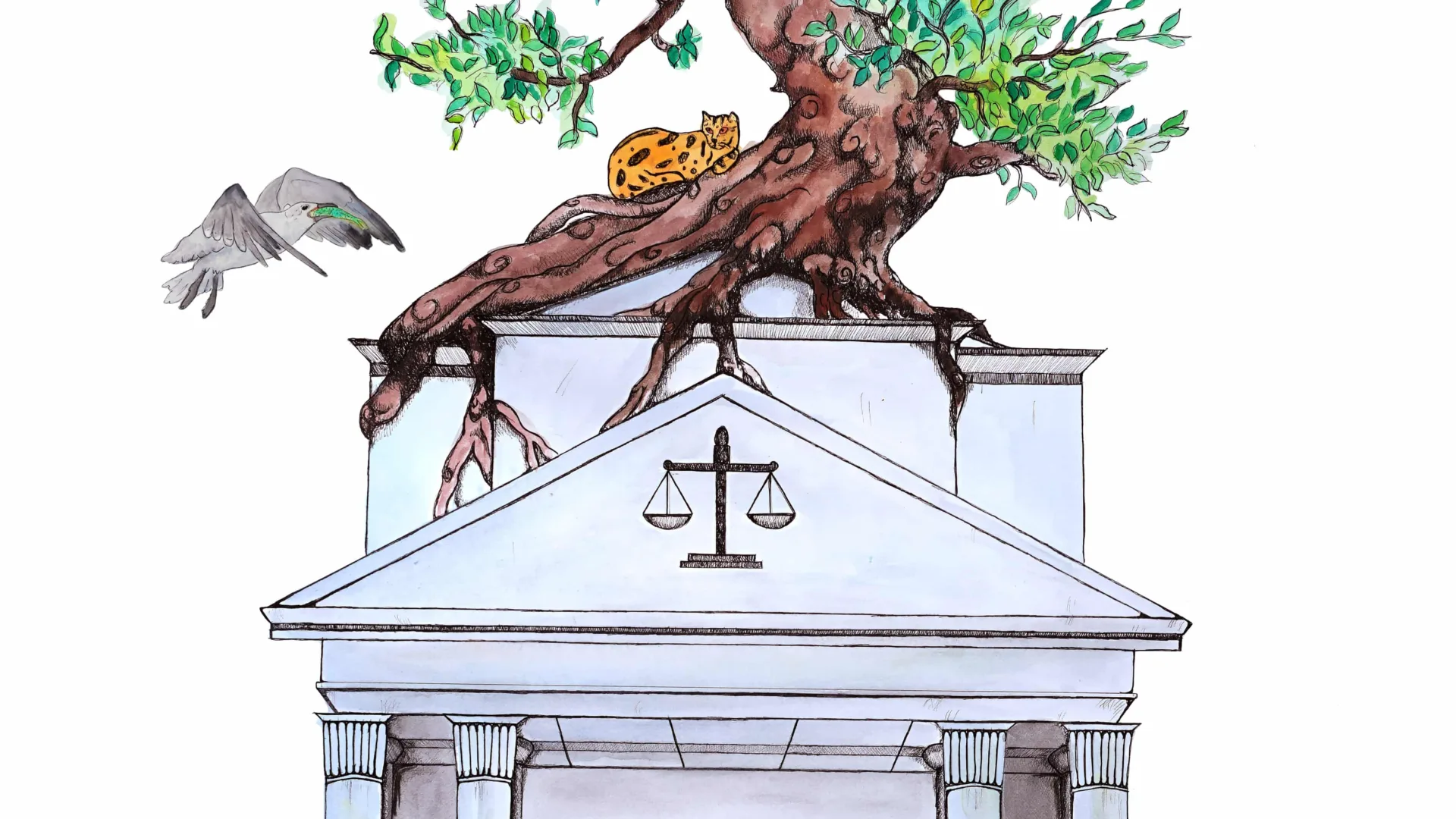Feature illustration by Talking Wings
In Commemoration of the September 2006 enactment of the first Rights of Nature legislation in Tamaqua, Pennsylvania, and the September 2008 enactment of the first constitutional recognition of the Rights of Pachamama in Ecuador, we are pleased to offer this updated and expanded proposal for the Legal Rights of Nature Principles.
These proposed legal principles are just that – proposals. Though we view these principles as important guides for how policy is developed, they are open to further refinement. We humbly invite members of Indigenous communities to review these principles. We acknowledge that developing these principles to guide future legislation is an ongoing project, to be informed by maturing understanding, real-world experiences, and regularly refined to address changing circumstances.
We also call upon our non-Indigenous allies across the globe, those who have engaged in the Rights of Nature Movement with integrity, to offer their input, critique, suggestions, and assistance in establishing, disseminating, and promoting these principles as a living evolving document. These principles are meant to help guide not just CELDF’s work, but all legal Rights of Nature work.
We anticipate a time for bringing allies together, Indigenous and non-Indigenous, representing our various communities and organizations, to arrive at a common understanding and agreement on the fundamental values that must be integral to the making of legitimate Rights of Nature law.
LEGAL RIGHTS OF NATURE PRINCIPLES
Proposed by Community Environmental Legal Defense Fund
September 2022

CELDF has been involved in establishing legal Rights for Nature in Western law since 2006, from the beginning of this movement’s contemporary phase. We recognize that institutionalizing the Rights of Nature requires a cultural paradigm shift that challenges and changes legal systems, as well as social, and moral behavior. For life on Earth to survive, and for humanity to persist as one of millions of living species, people and their governments must make a profound commitment, and that means acting earnestly, honestly, swiftly, and with integrity, not merely agreeing in principle with the need for transformation.
New laws must represent the values, morals, and needs that will shape culture and support and sustain a thriving and diverse Earth community. Giving preference to human convenience and luxury over the survival of non-human species has never been a viable strategy for a healthy future–in fact, such an orientation has undermined the survivability of the human species. The economic system that has been built on that human-centric value system now threatens to eradicate a significant part of the planet’s biosphere, while further enslaving the greater part of humanity in service to the privileges of the merest minority.
The necessary paradigm shift is attainable. By following the lead of Indigenous cultures and local community knowledge, we must reestablish humans as a part of Nature and not apart from it. This will automatically yield positive results for the majority of people and all of the living planet.
We have already seen cases of opportunistic co-optation of the term “Rights of Nature” that, if allowed to stand unchallenged, will work to dilute, neutralize, and defeat this movement. Therefore, we offer this statement of principles that we think are indispensable to Rights of Nature legislation, without which, we believe, the goals of the Rights of Nature movement will remain aspirational at best and become co-opted and subservient to the same agenda immanentizing Nature’s destruction.
Institutionalizing the legally enforceable Rights of Nature requires all of us to acknowledge our obligation to maintain inviolate certain basic rights inherent within and for the exclusive benefit of the natural world, unmediated by human convenience or preference. In its recent Los Cedros Forest decision, Ecuador’s Constitutional Court put it this way: “This is not a rhetorical lyricism, but rather a transcendent statement and a historical commitment that demands ‘a new form of civic coexistence, in diversity and harmony with nature.’”
Rights of Nature recognizes and honors that Nature has inalienable rights and is not property to be owned and exploited. Nature includes all ecosystems and living beings including watersheds, rivers, seas, mountains, flora and forests, animals, ecosystems, as well as humans, and all inorganic habitats in which organic beings dwell. These legal rights are a prudent and necessary recognition that humans are only one species on Earth and that respecting the Rights of Nature may restore the balance and interconnected health of Earth.
A new system of law based on respect for Nature and the obligations we share as collaborators with life-supporting ecosystems must be institutionalized, recognizing Nature as a unique legal entity and rights holder. We call upon communities, peoples, organizations, and governments to enact, implement, enforce, and to harmonize with Rights of Nature policies and laws that meet these minimum criteria, gleaned from the original New Orleans Statement of the Rights of Nature Symposium of October 28, 2017, from language adopted into law by CELDF partner communities, from the Ecuadorian Constitutional Court’s ruling in the Los Cedros Protected Forest case on November 10, 2021, and from the Ponca Tribal Law of Nature.
Accordingly, to be considered legitimate law instituting, protecting, and enforcing the legal Rights of Nature, our view is that each local, provincial, state, national, and international law purporting to advance the Rights of Nature must:
- Recognize the inherent, inalienable legal Rights of Nature and its constituent ecosystems, habitats, and natural communities to exist, flourish, self-organize, evolve, and regenerate, and to restoration, recovery, and preservation when harmed, interpreting these rights in the manner most favorable to the protection of Nature and constituent ecosystems.
- Define Nature and ecosystems so as to convey “a naturally occurring structural, functional and organizational unit, consisting of a community of organisms and the biotic and abiotic environmental variables that live and interact as a symbiotic whole in a given environment,” or stated differently, “Nature is a unique, indivisible, self-regulating community of interrelated beings that sustains, contains and reproduces all other beings. The term “being” includes ecosystems, natural communities, species and all other natural entities which exist as part of Nature.” (Article 1, Section 1 of the Ponca Tribal Law of Nature)
- Apply the Rights of Nature and Ecosystems such that “All beings are entitled to all the inherent rights recognized in this law without distinction of any kind, such as may be made between organic and inorganic beings, species, origin, use to human beings, or any other status; all beings have rights which are specific to their species or kind and appropriate for their role and function within the communities within which they exist; and the rights of each being are limited by the rights of other beings and any conflict between their rights must be resolved in a way that respects Nature and each being within Nature.” (Article 1, Section 4 of the Ponca Tribal Law of Nature)
- Ensure that the Rights of Nature are free from violation, regulation, and subordination to other laws, legal and financial liabilities, economic priorities, commodification, monetization, or classification by legal concepts such as “juristic personhood” where financial liabilities or resource valuations are imposed.
- Emancipate Nature, ecosystems, and living beings from the legal status of “property,” which allows for the violation of Nature’s rights by giving deference to vested legal privileges.
- Recognize that Nature includes human beings, when they are present, as a constituency, and that the very existence of humanity is inevitably tied to that of Nature, and that the Rights of Nature necessarily encompass the right of humanity to its existence as a species, and the right of Indigenous people and permanent residents to dwell unmolested in their natural habitat.
- Guarantee the ecosystem has legal standing to appear as the real party of interest in administrative proceedings and legal actions affecting its rights.
- Authorize residents of communities to represent the ecosystem in which they physically dwell, and ensure that they do so in the name of that ecosystem, for the sole purpose of advancing its rights, recognizing that they are part of that ecosystem and have legal standing, in any and all legal proceedings, to do so.
- Require full, transparent, understandable, accurate, and timely consultation and the informed consent of the resident human community representing an ecosystem that may be affected regarding proposed industrial, extractive, development, political, and financial activities before any activity begins.
- Apply the precautionary principle and restrictive measures, including locally promulgated prohibitions, for activities that may lead to the extinction of species, the destruction of ecosystems, or the permanent alteration of natural cycles whenever the majority of residents in a human community representing an ecosystem declares any action or omission may cause a violation of Nature’s rights to occur, even if there is no supporting scientific evidence.
- Require that damages derived from administrative, legal, contractual, or other proceedings be used solely and exclusively to protect, repair, and restore Nature in the affected ecosystem to assist in bringing it to its prior natural state.
These proposed legal principles are open to further refinement. We recognize that the collective professional experience of CELDF garnered from advocating for and assisting communities to implement legal Rights of Nature protections, does not constitute the only and last word on these crucial issues. We humbly invite Indigenous input, informed by traditional wisdom, to review these principles and share those insights. Understanding that legal rights are rooted in the legacy of Western colonial empires, and aspiring finally to achieve a global culture having internalized the values of respect, reverence, and obligation toward the living Earth, we acknowledge that developing these principles to guide future legislation is an on-going project, to be informed by maturing understanding and regularly refined to address changing circumstances in light of that understanding. Our aim in presenting these proposed principles is to embark on a journey of needed healing so that together, the whole of humanity may return to right-relationship with the rest of the living world.
We also call upon our non-Indigenous allies across the globe, those who have engaged in the Rights of Nature Movement with integrity, to offer their input, critique, suggestions, and assistance in establishing, disseminating, and promoting these principles as a living document. We anticipate a time for bringing allies together, Indigenous and non-Indigenous, representing our various communities and organizations, to arrive at a common understanding and agreement on the fundamental values that must be integral to the making of legitimate Rights of Nature law.



